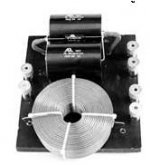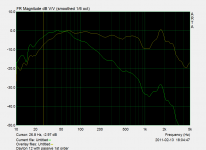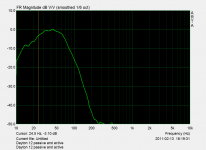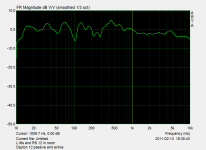I've wanted a musical sub for my HT for a long time now, and have finally built something I am proud of.
I chose the the Dayton Reference 12" RSS315HF-4 for the following reasons:
1) Distortion measurements from zaphaudio.com and mfk-projects.com showed this driver could produce bass that is not overwhelmed by harmonics.
2) It must be capable of 105db in-room down to 20hz. This is based on my typical listening volume of 75db a-weighted. When I get a little crazy I listen at 85db, and I wanted 20db of headroom. The Dayton RSS315HF can do this at about half of xmax.
3. I wanted a sub that could be crossed over high, at least 120hz. This one could definitely do it.
A teaser pic:
The box is built from 3/4" mdf, and braced with 3/4" 13-ply baltic birch. I figured the baltic birch is stiffer than mdf, so would make a good bracing material. The front and back baffles are also baltic birch. The magnet of the driver is wedged against a 4" wide brace.
The enclosure is 2.4 cu ft sealed, with no stuffing (a la LW thor).
I plan on taking distortion measurements and more pics later this weekend. More coming soon.....
Dan
I chose the the Dayton Reference 12" RSS315HF-4 for the following reasons:
1) Distortion measurements from zaphaudio.com and mfk-projects.com showed this driver could produce bass that is not overwhelmed by harmonics.
2) It must be capable of 105db in-room down to 20hz. This is based on my typical listening volume of 75db a-weighted. When I get a little crazy I listen at 85db, and I wanted 20db of headroom. The Dayton RSS315HF can do this at about half of xmax.
3. I wanted a sub that could be crossed over high, at least 120hz. This one could definitely do it.
A teaser pic:
An externally hosted image should be here but it was not working when we last tested it.
The box is built from 3/4" mdf, and braced with 3/4" 13-ply baltic birch. I figured the baltic birch is stiffer than mdf, so would make a good bracing material. The front and back baffles are also baltic birch. The magnet of the driver is wedged against a 4" wide brace.
The enclosure is 2.4 cu ft sealed, with no stuffing (a la LW thor).
I plan on taking distortion measurements and more pics later this weekend. More coming soon.....
Dan
I'm looking forward to your impressions when your build is complete. This driver is in my future, so I want to learn as much as possible about the do's and don't's. Zaph uses approx. 2.1 cuft. net volume. I was thinking about 2.6 to 2.8 sealed, similar to yours. Please tell me how you arrived at 2.4?
Regards, evad
Regards, evad
Thawach - At 100 watts this sub should be good for 94db @ 20hz, w/ 10mm excursion. After room gain I should be in 105db territory, but I will not know for sure until I take measurements. The upper limit will be determined by distortion measurements. If it's high enough, one day I hope to try a stereo pair with a reduced BSC speaker.
evad - I arrived at 2.4 cu ft by balancing foot print, baffle size, and performance with one or two drivers. I considered distortion, power requirements, internal reflections and structural strength. The design process was on and off for about 4 months.
badman - so far it sounds great, except it shakes the condo too much, limiting how loud I can play it. I need to find a way to decouple it from the floor, or get a second driver and go push-push. The box is designed for push-push, I just need to make the cutout.
Some more pics. I still need to route the back baffle with my flush trim bit.



Dan
evad - I arrived at 2.4 cu ft by balancing foot print, baffle size, and performance with one or two drivers. I considered distortion, power requirements, internal reflections and structural strength. The design process was on and off for about 4 months.
badman - so far it sounds great, except it shakes the condo too much, limiting how loud I can play it. I need to find a way to decouple it from the floor, or get a second driver and go push-push. The box is designed for push-push, I just need to make the cutout.
Some more pics. I still need to route the back baffle with my flush trim bit.



Dan
evad said:owdi Nice pix, I like your bracing scheme. Please tell me if you have considered making it a down firing sub? Also I'm interested in your spkr stands. The base looks very similar to sketches I'm working on. Glad your happy with the sq.
I have considered down firing, but I live in a condo with someone below me. The floors are not very solid, so I would be more limited in how loud I can listen.
The speaker stands are nothing special, just the Sanus 30" stands from partsexpress. They are just the right height for my zaphaudio L18's.
Dan
buggsson said:I have this driver on my short list. However, last time I looked, a couple of days ago, I could not find it, neither at Dayton or at PartsExpress, is it discontinued?
It is not discontinued. In fact, it's on sale right now for $20 less than usual.
Dan
Finally took a nearfield FR measurement... and found I really need a new receiver. The LP crossover in my Pioneer VSX-517 just does not cut it. It's set to 100hz right now, but the -3db is around 130hz. The -12db is around 300hz... that is bad.
I need either an amplifier with a built in 24db/octave LP and a parametric equalizer, or a Behringer Feedback Destroyer Pro.
I suspect the dip peak at 280hz is an enclosure resonance. The box is not stuffed right now, so there is nothing to dampen the primary pipe resonance. My enclosure is 24in deep, which happens to be the half wavelength of 281hz.
Dan
An externally hosted image should be here but it was not working when we last tested it.
I need either an amplifier with a built in 24db/octave LP and a parametric equalizer, or a Behringer Feedback Destroyer Pro.
I suspect the dip peak at 280hz is an enclosure resonance. The box is not stuffed right now, so there is nothing to dampen the primary pipe resonance. My enclosure is 24in deep, which happens to be the half wavelength of 281hz.
Dan
I added a quarter pillow worth of stuffing in between the braces, hoping it would attenuate the 280hz dip/peak. Instead the stuffing eliminated it, amazing.
The stuffing helped, but I still was not happy with how much midrange was creeping through. -20db @ 400hz and -40db @ 900hz is not very good for a subwoofer. I added a passive line level 1st order LP filter between the receiver and sub amplifier, and achieved excellent results.
-20db moved down to 250hz, and -40db fell to under 600hz. The reduced output at the crossover frequency allowed me to turn up the volume on the sub amp a little, without making the midbass overpowering. The results are better integration with the mains and more low bass
Dan
An externally hosted image should be here but it was not working when we last tested it.
The stuffing helped, but I still was not happy with how much midrange was creeping through. -20db @ 400hz and -40db @ 900hz is not very good for a subwoofer. I added a passive line level 1st order LP filter between the receiver and sub amplifier, and achieved excellent results.
An externally hosted image should be here but it was not working when we last tested it.
-20db moved down to 250hz, and -40db fell to under 600hz. The reduced output at the crossover frequency allowed me to turn up the volume on the sub amp a little, without making the midbass overpowering. The results are better integration with the mains and more low bass
Dan
evad said:Good to see you're making progress. Could you show me your LP filter design?
The filter is very simple, just a 10K ohm resistor in series and .88ufd capacitor in parallel with the input on the amplifier.
Thawach - I did not use a coil, only an resistor and capacitor. This is after the 2nd order digital crossover in my receiver, so the total rollof is about 18db/octave.
Dan
the crossover frequency allowed me to turn up the volume on the sub amp a little
owdi you got a chance. with this curcuit in the past i am afraid of it. because i lost the power too much. your respond graph looks good. -6 db at 120 hz if the sound of it's clear. i am happy with you.
regards
I really like your enclosure design... that shape is inherently stronger than any flat sided box and should have less resonance bouncing back into the cone, especially with the back wall so far from the woofer. Until you feel that Dayton woofer thumping, it's hard to imagine how strong it is or how important it is to have a strong enclosure, like yours. I just built a sub with that same woofer (see "Sub's all done") using 1.5" thick walls and that Dayton woofer still vibrates the box. Nice design... Nice Job!
Charlie
Charlie
I can't believe it's been 3 years since I built this subwoofer. It's sitting in my garage right now, still unfinished, but I've started sanding it down. At this rate it will be ready by 2015 
OK, here goes. I will have this finished within the next 3 months, or I'm scraping it and buying a kit. There I said it.
OK, here goes. I will have this finished within the next 3 months, or I'm scraping it and buying a kit. There I said it.
It's done, ... mostly. The enclosure is finished, but I still need to add feet or spikes.
I've attached my measured response curves. The first attachment shows nearfield unfiltered response (yellow) and nearfield filtered response with a passive line level filter (green). The filter is a simple RC filter, with a 10k resistor in series and 1uf cap in parallel with the input on my amplifier. The amp has an input impedance of 15k, and I believe the crossover frequency is about 16hz. Yeah, that is low, but it's first order and my receiver has no problem driving it. The main benefit is dropping the f3 from 40hz to 27hz, yum.
The second attachment shows nearfield response with the lowpass filter of my receiver set to 80hz. Looks like my receiver has a 24db/octave subwoofer crossover. Combined with my passive filter it makes for a 30db/octave slope, this thing just disappears.
The final attachment is farfield ungated in-room response at my listening area. My speakers are set to small, and there is a little too much midrange because they are only 2ft from the rear wall. The sub reaches down to 15hz.


I've attached my measured response curves. The first attachment shows nearfield unfiltered response (yellow) and nearfield filtered response with a passive line level filter (green). The filter is a simple RC filter, with a 10k resistor in series and 1uf cap in parallel with the input on my amplifier. The amp has an input impedance of 15k, and I believe the crossover frequency is about 16hz. Yeah, that is low, but it's first order and my receiver has no problem driving it. The main benefit is dropping the f3 from 40hz to 27hz, yum.
The second attachment shows nearfield response with the lowpass filter of my receiver set to 80hz. Looks like my receiver has a 24db/octave subwoofer crossover. Combined with my passive filter it makes for a 30db/octave slope, this thing just disappears.
The final attachment is farfield ungated in-room response at my listening area. My speakers are set to small, and there is a little too much midrange because they are only 2ft from the rear wall. The sub reaches down to 15hz.
Attachments
Some finished pics
An externally hosted image should be here but it was not working when we last tested it.
An externally hosted image should be here but it was not working when we last tested it.
An externally hosted image should be here but it was not working when we last tested it.
An externally hosted image should be here but it was not working when we last tested it.
An externally hosted image should be here but it was not working when we last tested it.
- Status
- This old topic is closed. If you want to reopen this topic, contact a moderator using the "Report Post" button.
- Home
- Loudspeakers
- Subwoofers
- My Dayton Reference 12" Subwoofer



